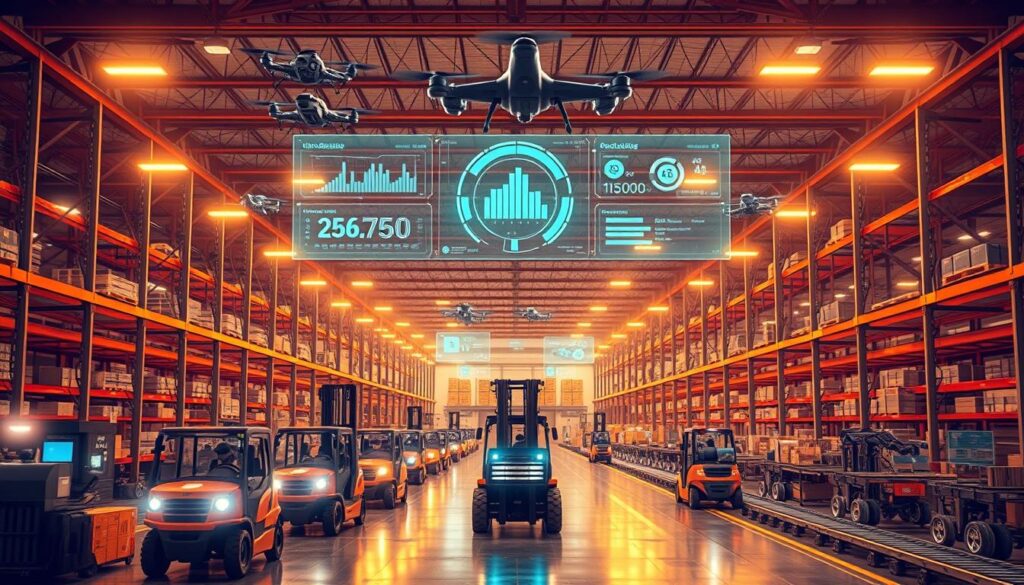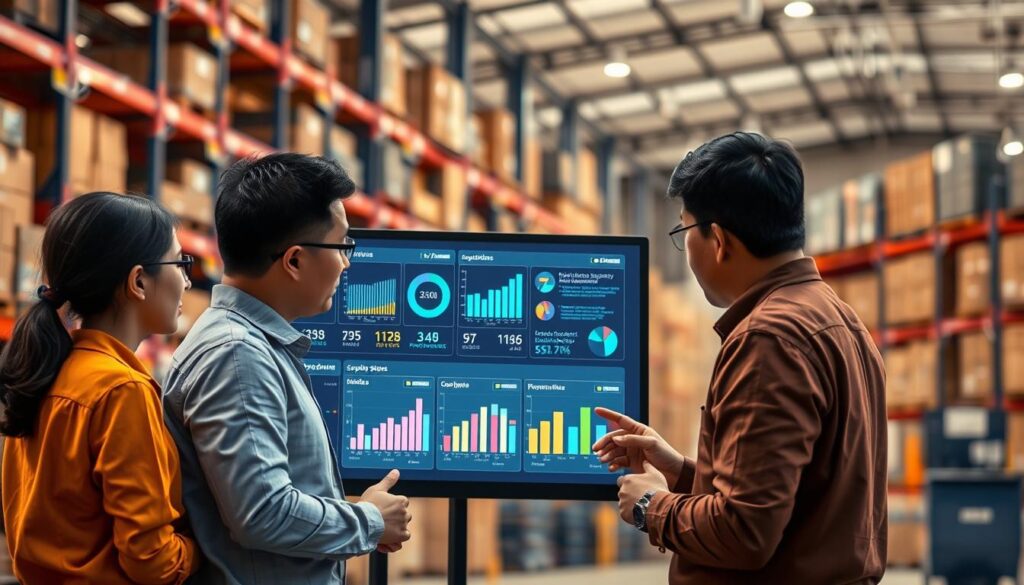Have you ever thought about how artificial intelligence can change the logistics world? It’s not just about automating tasks. AI is a game-changer for making supply chains better. It boosts efficiency and cuts costs, changing how things work.
The market for AI in logistics is expected to grow a lot. It will go from ₱171.96 billion in 2022 to ₱3.65 trillion by 2030. This shows companies see the value in using AI tools for logistics. This article will look at how AI is changing logistics, focusing on Southeast Asia where it can give a big advantage.
Key Takeaways
- The AI in logistics market is set to grow massively, with a forecast of over ₱3.65 trillion by 2030.
- AI tools streamline warehousing practices and logistics, leading to improved efficiency.
- Predictive analytics enhance demand forecasting and inventory management.
- AI technologies like chatbots and automated stock tracking can transform customer service.
- Companies leveraging AI can optimize routes and reduce operating costs significantly.
Understanding AI in Logistics
Artificial intelligence is changing many fields, and logistics is one of them. It helps track shipments, manage inventory, and find the best routes. This makes operations smoother, cuts down on problems, and speeds up decisions.
Supply chains today face many challenges, like market changes and disruptions. Companies must tackle these to stay ahead.
What is AI and How Does it Apply to Logistics?
AI means computers that do things that humans usually do. In logistics, it uses big data to find patterns and trends. For example, Uber Freight’s AI has cut down truck empty miles from 30% to 10% to 15%.
This big drop means less fuel used and more work done.
Importance of AI in Modern Supply Chains
AI is very important in logistics. Companies that use AI early on save 15% on logistics costs. They also see their inventory levels go up by 35%.
AI helps make logistics more agile and open. As old methods fail, AI is becoming key. It can learn and change on its own. With 97% of manufacturing CEOs planning to use AI soon, it’s a big change for the future.
Benefits of Using AI in Logistics
AI in logistics brings many benefits, changing the industry for the better. It makes supply chains faster and more efficient. This is thanks to automated tasks and smart algorithms that cut down on mistakes.
Increased Efficiency and Speed
AI makes warehouses run better by improving layouts and cutting down on inventory travel times. This leads to higher fulfillment rates, meeting customer needs. AI also helps in forecasting, making decisions based on real-time data.
With AI, you can test different scenarios without disrupting current operations. This boosts efficiency without causing problems.
Cost Reduction Strategies
AI in logistics helps save money in many ways. It reduces downtime by finding and fixing inefficiencies, saving manufacturers a lot. AI also finds errors and waste, lowering recalls and returns.
It makes delivery routes more efficient, cutting down on delays and saving money. AI uses data to find ways to use less energy and optimize truckloads. This helps the environment too.

Supply Chain Optimization with AI
In today’s fast-changing logistics world, AI plays a huge role in making supply chains better. It helps companies improve their processes, making them more efficient and cost-effective. This is mainly through better demand forecasting and managing inventory in real-time.
Predictive Analytics for Demand Forecasting
AI has changed the game in demand forecasting, reaching 95% accuracy. This high accuracy has helped companies cut inventory costs by 30% and boost sales by 10%. With AI, businesses can quickly adapt to market changes, using resources wisely and reducing waste.
Real-time Inventory Management
AI has changed how companies manage their inventory. It gives real-time data, helping them quickly respond to demand changes. This reduces the risk of running out of stock or having too much.
For example, big e-commerce companies have seen their picking speed increase by 200% and errors drop by 50%. This has led to a 30% better overall efficiency. These improvements make the supply chain more agile and responsive, showing how crucial AI is for optimization.
Leading AI Tools in Logistics
The logistics industry has seen big changes with AI tools. These tools help with things like forecasting and managing risks. They make companies more efficient and help them work better.
Overview of Popular AI Logistics Tools
Many AI tools have changed the logistics world. They help businesses run better. Here’s a table with some top tools and what they do:
| AI Tool | Functionality | Notable Achievements |
|---|---|---|
| IBM Watson | Data analysis and decision-making support | Improves delivery operations by predicting demand patterns |
| SAP Leonardo | Integration of IoT and machine learning | Enhances real-time tracking and inventory management |
| Oracle SCM Cloud | Supply chain planning and execution | Boosts efficiency through end-to-end visibility |
| ToolsGroup SO99+ | Inventory optimization and demand planning | Reduced inventory days from 61 to 35 for Gaviota |
| Overhaul’s RiskGPT | Risk management and incident response | Improved response times for cargo theft issues |
| project44 | Shipment tracking and visibility | Processes data from 1 billion shipments worth ₱56.7 trillion |
Case Study: A Southeast Asian Company Leveraging AI Tools
A top logistics company in Southeast Asia used smart technology. They used ToolsGroup’s Service Optimizer 99+ to get better at forecasting and managing stock. This cut their stock levels by 43% and lowered costs.

AI analytics helped the company serve customers faster and better. This shows how important AI tools are for improving logistics and supply chains.
Challenges in Implementing AI in Logistics
AI in logistics brings big chances, but it also comes with big challenges. Companies need to plan carefully to overcome these hurdles. Key issues include data privacy and making AI work with current systems.
Data Privacy and Security Concerns
Keeping customer data safe is a top concern with AI in logistics. Companies must follow strict rules to protect this information. This can be costly and requires a lot of effort to keep customers’ trust.
With over 65% of companies using AI, keeping data safe is more important than ever.
Integration with Existing Systems
Adding new AI to old systems is hard. Many companies use outdated systems that are hard and expensive to change. This slows down work.
Going from testing to full use of AI can make managing data even harder. It’s important to make data easy to access and use. This helps improve work flow and cuts down on waste.
Success Stories from Asian Companies
Asian companies have made big strides in their logistics by using AI. These stories show how AI has changed the game, making services better and saving money.
How Grab Optimized Delivery with AI
Grab has made its delivery service much better with AI. It uses AI to plan the best routes, cutting down on delays and making customers happier. Grab’s AI matches drivers with deliveries, making everything run smoother.
DHL’s Implementation of AI Solutions
DHL has started using AI to improve its logistics. It uses machine learning to make routes more efficient. This has cut delivery times by up to 30%.

| Company | AI Application | Results Achieved |
|---|---|---|
| Grab | Real-time Traffic Analysis and Route Optimization | Reduced Wait Times and Enhanced Efficiency |
| DHL | Machine Learning for Route Optimization | Delivery Time Reduction of Up to 30% |
Future Trends in AI for Supply Chains
The logistics industry is on the verge of big changes thanks to AI. Companies are turning to machine learning to make their operations better. They want to keep up with the changing market demands.
These advancements will change how logistics companies work. They will be faster, more accurate, and better at serving customers.
The Role of Machine Learning in Logistics
Machine learning is key for making logistics better. It helps businesses save 30% to 50% in their supply chain. AI’s predictive power improves forecasting, helping companies meet demand and manage risks.
By using big data, companies can adjust their stock levels quickly. This lets them keep up with what customers want. Learning more about AI’s role shows how it can make supply chains more visible and improve tracking.
Automation and Robotics in Warehousing
Automation and robotics are changing warehouse work. AI systems make order fulfillment faster, saving money and reducing mistakes. Semi-autonomous technologies in logistics improve fleet management and delivery.
AI helps plan routes, cutting costs by using real-time traffic data. It can turn days of planning into hours. By adopting these trends, logistics companies can stay ahead in a fast-moving market.
Best Practices for Adopting AI in Logistics
Adopting AI in logistics starts with a strong foundation. It’s about making decisions based on data and training teams well. By doing this, companies can improve how they work. They create a culture that values analytics and always looks for ways to get better.
Training teams to use AI is key. It makes the workplace more innovative. This way, everyone can work better together.
Building a Data-Driven Culture
A culture that values data helps AI adoption. It makes sure everyone can see and use data easily. This lets teams make better decisions fast.
Using real-time data helps teams understand the supply chain better. This makes them more efficient. It also cuts down costs and boosts profits.
With 76% of supply chains struggling to find skilled workers, data is crucial. It helps overcome these challenges.
Training and Development for Teams
Training teams is vital for getting the most out of AI. Programs that teach specific skills are needed. This helps teams use AI for better data analysis and inventory management.
This makes operations smoother. It also encourages teams to be creative and adapt to new situations. With 25% of companies already using AI, training is key to staying ahead.

Collaborating with Technology Partners
Using AI in logistics is more than just new tech. It’s about strong partnerships. In Southeast Asia, local partnerships offer insights and smooth integrations. They understand the regional market well.
Finding Reliable AI Vendors
Working with trusted AI vendors is key for logistics companies. They can use advanced tech to cut costs and boost efficiency. Vendors who know the local market help with inventory and demand forecasting.
With 37% of supply chain leaders planning to use AI soon, the right partner can make a big difference. Looking at different vendors ensures AI fits local rules.
Importance of Local Partnerships in Southeast Asia
Local partnerships in Southeast Asia boost AI’s power. Working with regional experts lets businesses tackle specific challenges. This includes better supply chain visibility and real-time tracking.
This teamwork improves efficiency and meets sustainability goals. As AI grows, these partnerships help supply chains adapt to changes.
| Benefits of Collaborating with Local Partners | Impact on AI Implementation |
|---|---|
| Customized Solutions | Tailored approaches that cater to specific regional challenges |
| Enhanced Support | Local expertise ensures quicker response times and better adaptation |
| Regulatory Compliance | Better understanding of local laws and standards for smoother integration |
| Sustainability Focus | Working together on eco-friendly solutions enhances overall operational efficiency |
Conclusion: The Path Forward for AI in Logistics
The world of logistics is changing fast, thanks to AI. In the Philippines, using AI is key for keeping up with supply chain challenges. AI robots can do warehouse tasks better than humans, and predictive analytics can guess demand accurately.
These tools make operations more efficient and help businesses compete globally.
Final Thoughts on AI’s Role in Supply Chain Optimization
Businesses are seeing the many benefits of AI. They should focus on getting more people to use AI in logistics. Companies that use AI see big savings in costs and faster delivery times.
AI helps plan routes and manage inventory, leading to better supply chain efficiency in the future.
Encouraging Adoption Among Business Leaders in the Region
In Southeast Asia, the logistics sector’s future depends on leaders embracing AI. By choosing AI, companies can make their operations smoother and meet global standards for sustainability and reliability.
Overcoming the first steps of using AI is important. It’s vital to create a culture that supports innovation and new technologies. With AI, the logistics industry is set for a smarter, more efficient future.

